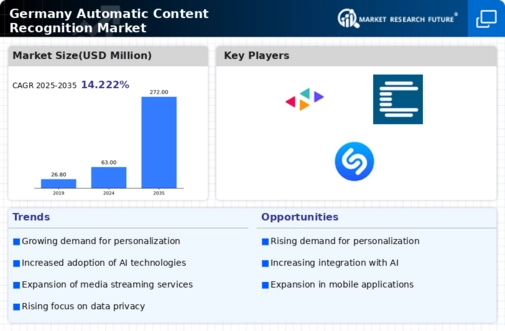The automatic content-recognition market is currently characterized by a dynamic competitive landscape, driven by rapid technological advancements and increasing demand for content personalization. Major players such as Google LLC (US), Apple Inc (US), and Amazon.com Inc (US) are at the forefront, leveraging their extensive resources to innovate and enhance their offerings. Google LLC (US) focuses on integrating AI capabilities into its content-recognition systems, aiming to improve user experience and engagement. Meanwhile, Apple Inc (US) emphasizes privacy and security in its content-recognition technologies, positioning itself as a leader in user trust. Amazon.com Inc (US) is expanding its cloud-based solutions, enhancing its content-recognition services to cater to a growing e-commerce sector, thereby shaping a competitive environment that prioritizes innovation and user-centric solutions.
Key business tactics within this market include localized manufacturing and supply chain optimization, which are essential for meeting the diverse needs of consumers across different regions. The competitive structure appears moderately fragmented, with several key players exerting influence over market dynamics. This fragmentation allows for a variety of approaches to content-recognition technologies, fostering an environment where innovation can thrive, albeit with challenges related to market saturation and differentiation.
In October 2025, Google LLC (US) announced a partnership with a leading European media company to enhance its content-recognition capabilities, aiming to provide more tailored advertising solutions. This strategic move is likely to bolster Google's position in the market by integrating advanced analytics and machine learning, thereby improving the effectiveness of targeted advertising. Such partnerships may also facilitate access to new data sources, enhancing the overall performance of their content-recognition systems.
In September 2025, Apple Inc (US) launched a new feature within its iOS ecosystem that utilizes advanced content-recognition algorithms to enhance user privacy. This initiative not only reinforces Apple's commitment to user security but also differentiates its offerings in a crowded market. By prioritizing privacy, Apple may attract a segment of consumers increasingly concerned about data security, potentially leading to increased market share.
In August 2025, Amazon.com Inc (US) expanded its content-recognition services within its AWS platform, introducing new tools for developers to create customized applications. This expansion is strategically significant as it positions Amazon as a key player in the B2B segment of the market, allowing businesses to leverage content-recognition technologies for their specific needs. Such developments could lead to increased adoption of these technologies across various industries, further solidifying Amazon's competitive edge.
As of November 2025, current trends in the automatic content-recognition market are heavily influenced by digitalization, sustainability, and the integration of AI technologies. Strategic alliances among key players are shaping the landscape, fostering innovation and collaboration. Looking ahead, competitive differentiation is likely to evolve, with a shift from price-based competition to a focus on technological innovation and supply chain reliability. Companies that can effectively harness these trends will likely emerge as leaders in the market.














Leave a Comment